Zvezda 1/48 Bf-109F-2
|
KIT #: |
4802 |
|
PRICE: |
2240 yen at Hobby Link Japan
|
|
DECALS: |
Five options |
|
REVIEWER: |
Tom Cleaver |
|
NOTES: |
|
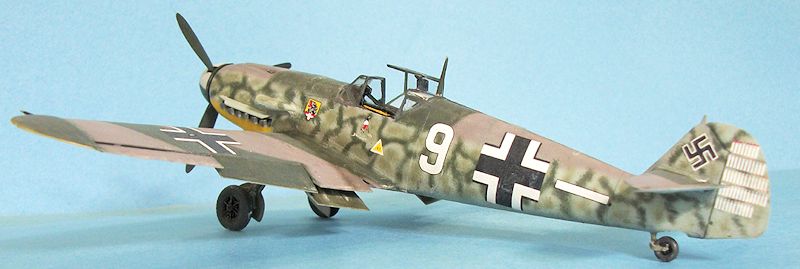
The Bf‑109F, or Friedrich, is commonly considered the high point
of development of the airframe technically, in terms of mating power to airframe
for maximum performance. The
Bf-109f is certainly the best‑looking Bf‑109 overall. The aircraft was a major
redesign of the Bf-109 to take maximum advantage of the DB-601, with
shorter-span, wider-chord ailerons to improve maneuverability, and a fully
cantilever horizontal stabilizer.
Pilots considered it the best handling of all the 109s, and felt that the
later Gustav and Kurfurst series did not increase performance for
the extra weight of armament and different engines.
It did however stir controversy by the reduction in armament compared to
the Bf-109E, with only a single 15 or 20mm cannon mounted on the centerline, and
two 7.62mm machine guns. While
Werner Moelders believed this was a good armament fit, Adolf Galland believed it
was a retrograde step, that the average Luftwaffe pilot was not such a superb
marksman as was Moelders, and thus needed the extra weight of fire from two
cannons.
First appearing in limited
numbers on the Channel Front in November 1940, the Friedrich canceled the
performance edge of the new Spitfire V over the Bf‑109E, allowing the Luftwaffe
to maintain air superiority against the RAF over the Channel and Northern France
during the “Non‑Stop Offensive” of 1941.
The Bf‑109F was clearly the best fighter operational over the Eastern
Front after the opening of
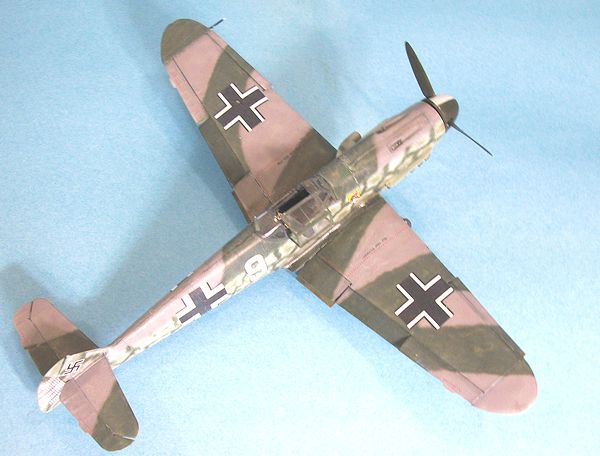 Operation Barbarossa in June 1941.
Operation Barbarossa in June 1941.
Hans Phillipp:
Born in 1917, Hans Phillip joined the Luftwaffe in 1936. On completion of
training as a fighter pilot, he was assigned to I./JG 76.
Flying with the unit during the Polish campaign, Phillips scored his
first victory in the first week of the war.
During the reorganization of the Jagdwaffe before the campaign in the
West, I/JG 76 became II/JG 54.
Flying in the Battle of France and the Battle of Britain, Philipp was promoted
Staffelkapitän of 4./JG 54 following the award of the
Knight's Cross of the Iron Cross (Ritterkreuz des Eisernen Kreuzes) for
20 victories on November 4, 1940.
On the opening day of the Balkans campaign in April 1941, JG 54 engaged
the Bf 109E's of the Jugoslovensko Kraljevsko Ratno Vazduhoplovstvo
(JKRV—Yugoslav Royal Air Force). Hans Philipp claimed two of the JKRV
Messerschmitts during the massive air battle.
JG 54 was assigned to the Northern Front in Operation Barbarossa, the
invasion of the Soviet Union that began on June 22, 1941.
By August 24, 1941, Hans Philipp became the thirty-third recipient of the
Oak Leaves to the Knight's Cross, and was appointed Kommandeur I./JG 54.
Phillipp’s success in air combat continued and in March 1942, he was the
first pilot in JG 54 to be awarded the Swords to the Knight's Cross.
On March 31, 1942, Philipp became the fourth Luftwaffe fighter
pilot to achieve 100 victories.
Transferred to the Western Front in the sp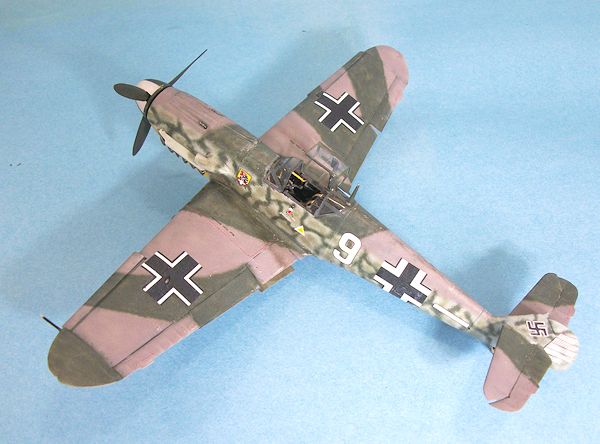 ring of 1943 after scoring 178
victories on the Eastern Front, Phillipp became Geschwader Kommodore of
JG 1, based in Holland and Northwestern Germany, where he faced the growing
strength of the Eighth Air Force.
ring of 1943 after scoring 178
victories on the Eastern Front, Phillipp became Geschwader Kommodore of
JG 1, based in Holland and Northwestern Germany, where he faced the growing
strength of the Eighth Air Force.
On October 8, 1943, the Eighth Air Force sent 156 bombers to targets in
Bremen and Vegesack, escorted by over 250 P-47 Thunderbolts from six fighter
groups. Phillipp's Stab Flight was intercepted by P‑47's of the 56th Fighter
Group. Philipp was heard to
announce a victory over a Thunderbolt. His last transmission was, "Reinhardt,
attack!" Feldwebel Reinhardt, Philipp's wingman, last saw the
Kommodore's aircraft disappear in a cloud.
Wounded after colliding with an enemy aircraft, Reinhardt made a
successful forced landing. That
evening, the Geschwader learned Phillipp had been shot down and
killed.[2]
In 500 missions between September 1, 1939 and October 8, 1943, Hans
Philipp claimed a total 206 enemy aircraft shot down, 178 on the Eastern front,
29 against the Western Allies.
When Zvezda’s 1/48 Bf-109F-2 was released in 2010, Those Who Fret About
These Things proclaimed it the first really accurate kit of the Bf-109F-2 ever
released. The kit provides parts to
do both the early and late production Bf-109F-2, with separate wingtips with the
early and late production navigation lights, and different lower fuselage center
sections, as well as different windscreens including a separate armored glass
for the pre-production version. The
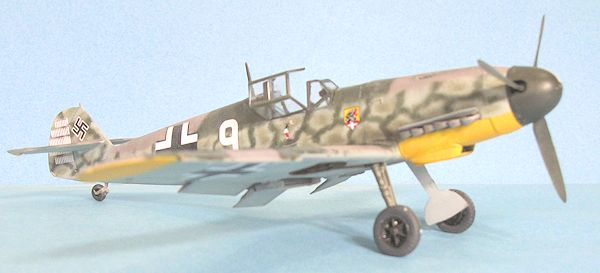 upper wing surface is in one piece without panel lines, the first time this has
been accurately portrayed in a kit of the early Friedrich.
The propeller is also the correct narrow chord and shape, and the spinner
is also accurate.
upper wing surface is in one piece without panel lines, the first time this has
been accurately portrayed in a kit of the early Friedrich.
The propeller is also the correct narrow chord and shape, and the spinner
is also accurate.
The kit comes with a full engine and armament interior for the nose, and
the cowling parts can be posed open.
Separate parts without internal detail are provided for assembly in the
closed position. A modeler doing
the closed-up version should use some thin Evergreen sheet to reinforce the
butt-joint assembly of this area.
Decals are provided for five different Bf-109Fs.
There is also a veritable plethora of aftermarket decals for the
Bf-109F-2 that most modelers will likely already have in their collections.
Due to the number of parts, the kit is very fiddly.
This is exacerbated by the fact there is no identification letter on any
of the three sprues, while the instructions indicate one should be dealing with
“Sprue A” and “Sprue B.”
Fortunately, the guesswork does not include the individual parts, which are
correctly numbered. Once one can
identify which sprue is which, the process becomes easier.
It is also important to determine if you are doing “Version 1", which is
an early-production Bf-109F-2, or “Version 2" which is the later-production
version, since this determines which of all the alternative parts you will be
using throughout the construction.
Parts fit is very good. Test
fit carefully and you will not need to use putty or filler.
I should point out that the landing gear is designed so that it cannot be
placed incorrectly, which can be problematic with other Bf-109 kits, to get the
angle of forward rake and spread right; this is a very nice touch.
My initial plan was to build the model with the engine compartment open.
In 1/48 scale, this is pretty easily done since it is not big enough to
require lots of small additional detail, as is the case with a 1/32 kit.
I assembled all the interior, and then managed to drop and step on the
left engine mount. At
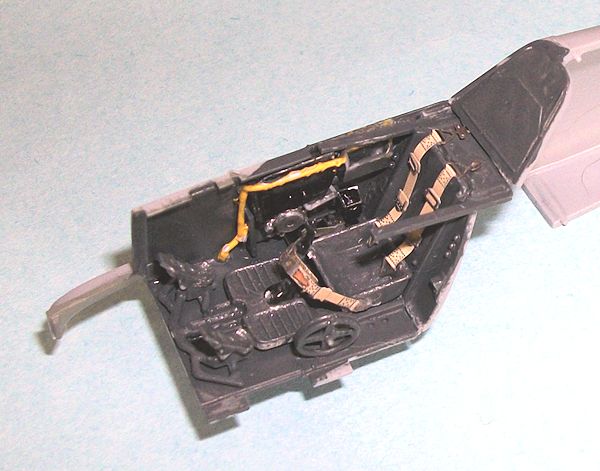 that point I
had to disassemble a lot of the interior to allow proper fit of the cowling
closed up, which did make a whole lot of mess.
To top it off, once I had the model finally assembled this way, I made
the discovery that there are two alternative left engine mounts, and that the
one I had stepped on was the wrong one for the version I was doing, and that the
correct part was still on the sprue!
ARRGGHHHHH!!!!
that point I
had to disassemble a lot of the interior to allow proper fit of the cowling
closed up, which did make a whole lot of mess.
To top it off, once I had the model finally assembled this way, I made
the discovery that there are two alternative left engine mounts, and that the
one I had stepped on was the wrong one for the version I was doing, and that the
correct part was still on the sprue!
ARRGGHHHHH!!!!
I can however tell you that all the parts fit very nicely for whichever
way you wish to go, and that the parts provided in the kit for the engine and
other interior parts are far superior to the resin parts that have been the only
other way to do a Bf-109 “opened up.”
I may just get another one of these to finally do that right.
The cockpit provides the best detail of any 1/48 Bf-109 kit; of course
it’s all very small and as such it is Optivisor Time when it comes to assembly.
I only used Eduard photoetch seat belts to put that final bit to the
cockpit.
So, take your time, identify the sprues, identify the parts correctly,
identify the particular sub-type of Bf-109F-2 you intend to build, and you will
have a very nice model when it comes time for paint and decals.
At the point of discovering that I had completely screwed up the
open-cowling option I had planned on, the model went back in its box and sat on
the shelf of doom for about 29 months, until last month when I was clearing
things away and took another look, deciding that it could still be turned into a
nice model, just not the model intended.
So I attached the closed cowling pieces which fit just fine, and
completed it as a buttoned-up model.
I’ve always been attracted to the airplanes of JG 54 on the Eastern
Front. The unit was in the
positions it would maintain for the next two and a half years by the fall of
1941, and took the time to repaint the aircraft to give the best camouflage for
combat over the great dark northern forests of the Leningrad region.
Of particular note has always been the “lizard scheme” applied to Bf-109s
of II 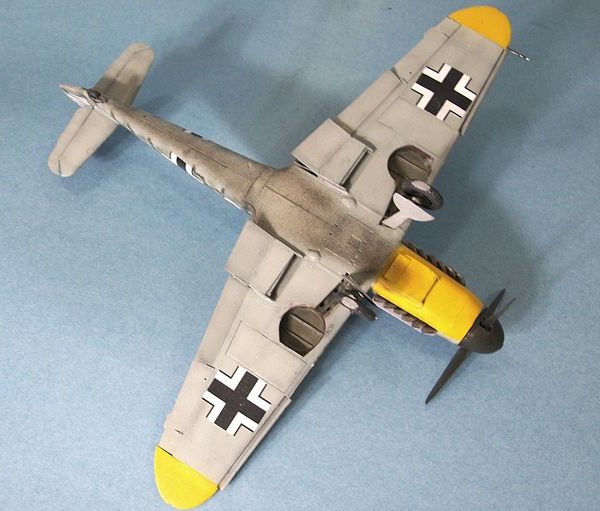 Gruppe. Thus, I had no
problem choosing to do Hans Phillipp’s airplane from October 1941, when he had
46 victories. After pre-shading the
model and then applying the yellow tactical markings that I masked off, I
freehanded the 74/75/76 scheme with the “lizard skin” done with RLM74 and RLM02,
using mixed paints created from Tamiya acrylics.
Lifelike Decals provides comprehensive color painting guides with the
decals. When all that was done, I
gave the model a coat of Future and it was time for the decals.
Gruppe. Thus, I had no
problem choosing to do Hans Phillipp’s airplane from October 1941, when he had
46 victories. After pre-shading the
model and then applying the yellow tactical markings that I masked off, I
freehanded the 74/75/76 scheme with the “lizard skin” done with RLM74 and RLM02,
using mixed paints created from Tamiya acrylics.
Lifelike Decals provides comprehensive color painting guides with the
decals. When all that was done, I
gave the model a coat of Future and it was time for the decals.
As Lifelike points out in their instructions, there has been controversy
over whether or not Phillipp’s airplane would have been “White-9" or “Yellow-9";
Lifelike comes down on the side of white on the point that this is the proper
color for the 4th Staffel in Luftwaffe color coding instructions.
The decals are very thin and go down under a coat of Micro-Sol without
difficulty.
I gave the model a coat of Xtracrylix Clear Flat varnish, then applied
exhaust stains with Tamiya “Smoke.”
I attached the prop and landing gear, and unmasked the canopy, which was posed
in the open position.
The experts are right, this is the best Bf-109F-2 kit available in 1/48
scale, given the accuracy of the small detail.
Assembly is fiddly but not all that difficult, and a modeler with average
hand-eye coordination and the ability to follow instructions should have no
problems. The result is an
excellent model, and - as noted above - with the large number of aftermarket
sheets for the Friedrich that are out there, one can make any of a number of
nice looking models with this kit.
Highly recommended. (BTW - the
model is now US$5.00 cheaper than it was when first released, due to changes in
the exchange rate)
Tom Cleaver
July 2013
Review kit courtesy of HobbyLink Japan - order yours
here. This is the link for
Lifelike decals.
If you would like your product reviewed fairly and fairly quickly, please
contact
the editor or see other details in the
Note to
Contributors.
Back to the Main Page
Back to the Review
Index Page



 ring of 1943 after scoring 178
victories on the Eastern Front, Phillipp became Geschwader Kommodore of
JG 1, based in Holland and Northwestern Germany, where he faced the growing
strength of the Eighth Air Force.
ring of 1943 after scoring 178
victories on the Eastern Front, Phillipp became Geschwader Kommodore of
JG 1, based in Holland and Northwestern Germany, where he faced the growing
strength of the Eighth Air Force.  upper wing surface is in one piece without panel lines, the first time this has
been accurately portrayed in a kit of the early Friedrich.
The propeller is also the correct narrow chord and shape, and the spinner
is also accurate.
upper wing surface is in one piece without panel lines, the first time this has
been accurately portrayed in a kit of the early Friedrich.
The propeller is also the correct narrow chord and shape, and the spinner
is also accurate. that point I
had to disassemble a lot of the interior to allow proper fit of the cowling
closed up, which did make a whole lot of mess.
To top it off, once I had the model finally assembled this way, I made
the discovery that there are two alternative left engine mounts, and that the
one I had stepped on was the wrong one for the version I was doing, and that the
correct part was still on the sprue!
ARRGGHHHHH!!!!
that point I
had to disassemble a lot of the interior to allow proper fit of the cowling
closed up, which did make a whole lot of mess.
To top it off, once I had the model finally assembled this way, I made
the discovery that there are two alternative left engine mounts, and that the
one I had stepped on was the wrong one for the version I was doing, and that the
correct part was still on the sprue!
ARRGGHHHHH!!!! Gruppe. Thus, I had no
problem choosing to do Hans Phillipp’s airplane from October 1941, when he had
46 victories. After pre-shading the
model and then applying the yellow tactical markings that I masked off, I
freehanded the 74/75/76 scheme with the “lizard skin” done with RLM74 and RLM02,
using mixed paints created from Tamiya acrylics.
Lifelike Decals provides comprehensive color painting guides with the
decals. When all that was done, I
gave the model a coat of Future and it was time for the decals.
Gruppe. Thus, I had no
problem choosing to do Hans Phillipp’s airplane from October 1941, when he had
46 victories. After pre-shading the
model and then applying the yellow tactical markings that I masked off, I
freehanded the 74/75/76 scheme with the “lizard skin” done with RLM74 and RLM02,
using mixed paints created from Tamiya acrylics.
Lifelike Decals provides comprehensive color painting guides with the
decals. When all that was done, I
gave the model a coat of Future and it was time for the decals.